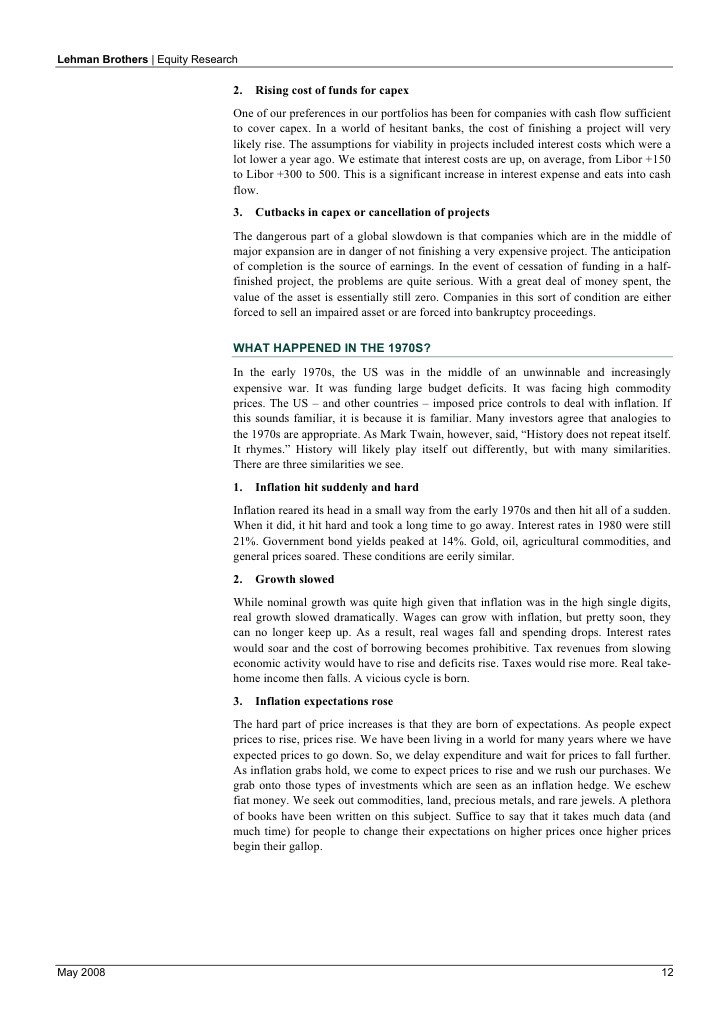Stagflation Definition Causes Can It Happen Now
Post on: 6 Июль, 2015 No Comment

What Is It, What Causes It, and Can It Happen Again?
Definition: Stagflation is when the economy experiences stagnant economic growth. high unemployment and high inflation. It’s a highly unusual situation because a slow economy usually reduces demand enough to keep prices from rising. As workers get laid off, they buy less. As a result, businesses get into a competitive price war to attract whatever customers remain. Slow growth in a normal market economy prevents inflation.
What Causes Stagflation?
Stagflation is caused by circumstances similar to those that create hyperinflation. Both extreme situations have only occurred when expansive fiscal or monetary policy artificially boosted the money supply at the same time when supply was constrained. Fiscal policy can print more currency, while monetary policy creates more credit. If supply is limited or shut down, then companies can’t produce more to meet the demand created by the extra money supply.
This situation occurred in Zimbabwe in 2004. However, the government created so much money it went beyond stagflation and turned into hyperinflation. Stagflation in the U.S. only occurred during the 1970s when the Federal government manipulated its currency to spur economic growth, but restricted supply with wage-price controls.
Stagflation in the 1970s
Stagflation got its name during the 1973 — 1975 recession. There were six quarters of shrinking Gross Domestic Product (GDP), while inflation tripled in 1973, rising from 3.4% to 9.6%. It remained between 10-12% from February 1974 through April 1975. (Source: BEA, 1970-1979 GDP; BLS, Chart of 1970-1979 Inflation)
How did this happen? Many experts blame the 1973 oil supply shocks, when OPEC cut its quota and prices quadrupled. This did trigger some oil price inflation. However, it took fiscal and monetary policy combined to create this extreme stagflation.
It all started with a mild recession in 1970. Unemployment was at 6.1%, a result of the economy contracting for three quarters. President Richard Nixon was running for re-election, and looked for a way to boost growth without triggering inflation. On August 13 1971, Nixon and his aides formulated four economic policies that would succeed in getting Nixon re-elected. Without realizing it, they also sowed the seeds for stagflation.
First, Nixon instituted wage and price controls, freezing businesses’ ability to raise prices in the U.S. When import prices rose, U.S. businesses couldn’t raise prices to remain profitable. Instead, they had to reduce costs. Since they couldn’t lower wages, they had to lay off workers. This raised unemployment, reducing demand, and slowing economic growth.
Why did import costs rise? This was a result of Nixon’s second action — removing the U.S. from the gold standard. which had kept the dollar’s value tied to a fixed amount of gold. Nixon did this to prevent a run on the gold reserves at Fort Knox. Under the Bretton Woods Agreement. most countries pegged the value of their currencies to either the price of gold or the dollar. This turned the dollar into a global currency. As a result, demand for the dollar rose. The crisis was precipitated when Great Britain tried to redeem $3 billion for gold.
When Nixon took the U.S. off of the gold standard. the price of gold skyrocketed — from $35 an ounce to $120 an ounce. At the same time, the value of the dollar plummeted. The result? Import prices rose.
To fight inflation, the Fed kept raising the Fed funds rate. reaching a peak of 20% in 1979. However, instead of signaling the market and being consistent, the Fed did so in a stop-go fashion. This confused businesses, many of whom kept prices high. (Source: A Monetary Explanation of the Great Stagflation of the 1970s. Robert B. Barsky, University of Michigan and NBER; Lutz Kilian, University of Michigan and CEPR, 2000; Wall Street Journal, The Nixon Shock Heard ‘Round the World. August 15, 2011)
Can Stagflation Reoccur?
In 2011, people became concerned that the expansive monetary policies the Fed used to rescue the economy from the 2008 financial crisis would cause inflation. This was combined with expansive fiscal policy. such as the economic stimulus package and record levels of deficit spending. At the same time, the economy was only growing at about 1-2%. People warned about the risk of stagflation, if inflation got worse and the economy didn’t grow faster.
However, this sudden increases in global liquidity was needed to successfully ward off deflation, which was a far greater risk at the time. The Fed won’t allow inflation to go beyond its inflation target of 2% for the core inflation rate. If inflation rose above that target, the Fed would reverse course, and institute constrictive monetary policy.
Other unusual conditions that created stagflation in the 1970s are highly unlikely to be repeated. First, the Fed no longer practices stop-go monetary policies. Instead, it clearly signals a consistent monetary direction. Second, the removal of the dollar from the gold standard was a once-in-a-lifetime event. Third, the wage-price controls that constrained supply wouldn’t even be considered today. Article update September 1, 2014














